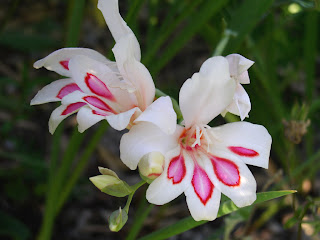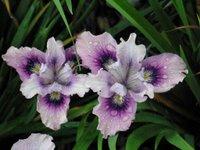As I write this it is Sunday evening and it is very hot - our late and dry summer continues without abatement. In the un-watered parts of our garden things are very dry and in paddocks all around our district the naked ladies have made their appearance, splashes of bright pink showing against the straw shades of the pasture.
I refer to the bulbs, Amaryllis belladonna, of course, rather than unclothed female members of the rural community.
I have had a trying week. My seed from the Society for Pacific Coast Native Iris was found to have a slight fungal infection when it arrived at the border in Auckland International Airport. As a result it has had to all be destroyed. Although I am slightly frustrated, I so understand why they did what they did, and I support the work that the inspectors do, so I’ll just have to grin and bear it. I have a lot of seed from my own crosses, and as others lost their seed at the border, I’ll share that around with some of the other growers.
I have been cursing the very dry season too. Autumn is one of my favourite times of the year and I love looking through the bulbs on offer in nurseries, working out what I am going to plant this season. I have to say that the warm and dry garden has put me off a little, but this weekend I did go down to the garden shop to select a few bulbs.
I have grown to love Gladiolus as I have aged, not something I might have predicted. Their showy flowers are sometimes difficult to place properly in the garden, but I grow a few for the house in my picking garden and wouldn’t be without them now.
This is, of course, not the right time to be planting florists’ gladiolus, the type most of us grow, but the dwarf forms should be planted now. I already a large clump or two of these, but I have added a few more varieties this season.
These are usually sold as Gladiolus nanus, but this name seems to have no authority. It is just used to describe the dwarf early flowering forms. They are unlike the larger florist forms, and although they are a similar size to the summer flowering “butterfly” gladiolus they are much more wild-flower looking.
These “nanus” forms should probably be called G. colvillei, the name given to winter-flowering hybrids based on G. tristis and G. cardinalis.
G. tristis is a highly scented species from South Africa, sometime available from specialist bulb nurseries. It usually has slightly insipid flowers but it makes up for that by having the most wonderful scent, especially noticeable at night. As you would expect G. cardinalis is bright red flowered. It is also likely that G. carneus is involved as many hybrids have flashes of colour on their bottom petals very reminiscent of this species.
Perhaps the most famous of these the variety known as ‘The Bride’; it has white flowers with a greenish centre to each flower, giving a very cool look in the garden. ‘Nymph’ is another very reliable older form. In this case the white flowers have cream markings on the bottom three petals, each cream area being surrounded with a thick carmine pencil line. These two are both very hardy and long-lasting varieties, and both do well in my garden.
This year I am adding ‘Halley’ and ‘Charming Lady.’ I hadn’t seen ‘Halley’ before and was taken with its creamy yellow flowers, set of with a red throat, colours more usually associated with the larger hybrids. I assumed that it was a new form – I was somewhat taken aback to stumble across a reference to it in a 1917 garden journal! The journal recommended planting this with yellow Californian poppies (Eschscholzia) but as I have only just this year managed to weed out the last of the white ones I planted nearly ten years ago I don’t think I’ll be doing that! I think I’ll plant them in the garden I have filled with other yellow flowers. I think it will flower about the same time as the white and yellow freesias.
“Charming Lady” is quite different to the foregoing, in that it has pale pink flowers shoot through with lilac. It is lighter in the centre. I have a garden with Alliums and other spring flowering bulbs and I think these colours will all go together very well.
At the other end of the flowering season – about now in fact- comes another fabulous Gladiolus species – well, it is now, but for most of my gardening career it was an Acidanthera. The botanists have rightly decided that it is in fact a Gladiolus – it will even cross with the large flowered hybrids.
This is another South African species with hooded white flowers and showy maroon blotches, coupled with an attractive scent. It is sometimes called Peacock Gladiolus, or even Peacock Orchids, although it is, of course, not remotely related to orchids. When crossed with the larger flowered forms some scent is brought across with the genes, but this is soon swamped in further crosses, so the elusive scented florists’ gladiolus looks as far away as ever.
All of these species prefer well-drained soil and will cope with full sun without any bother. In the hardest of climates they need lifting for winter but nothing in our region should pose any threat to them. You might need to keep an eye out for thrips in a dry season though. Apart from that they are plant-and-forget plants.


